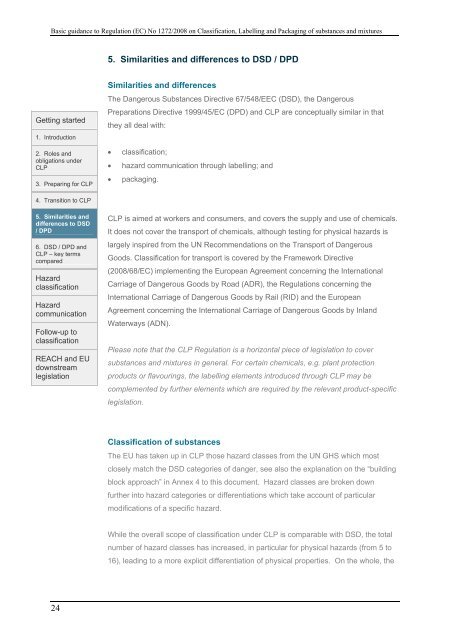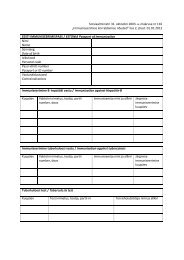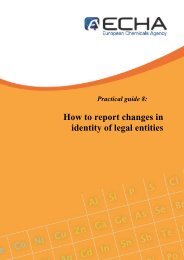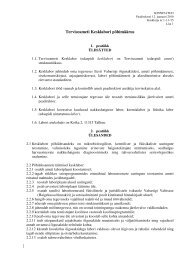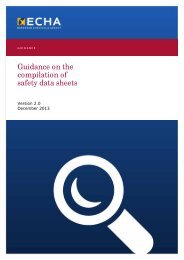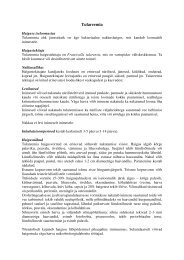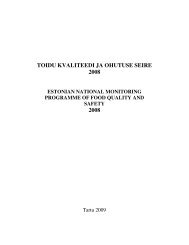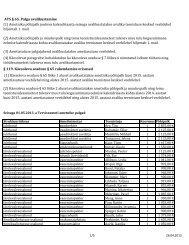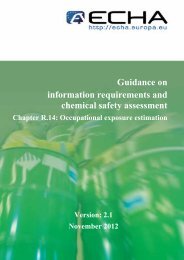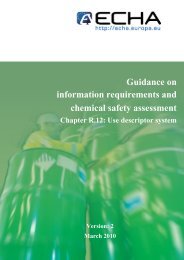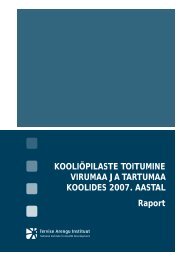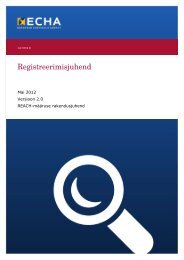Introductory Guidance on the CLP Regulation - ECHA - Europa
Introductory Guidance on the CLP Regulation - ECHA - Europa
Introductory Guidance on the CLP Regulation - ECHA - Europa
You also want an ePaper? Increase the reach of your titles
YUMPU automatically turns print PDFs into web optimized ePapers that Google loves.
Basic guidance to Regulati<strong>on</strong> (EC) No 1272/2008 <strong>on</strong> Classificati<strong>on</strong>, Labelling and Packaging of substances and mixtures<br />
5. Similarities and differences to DSD / DPD<br />
Getting started<br />
1. Introducti<strong>on</strong><br />
2. Roles and<br />
obligati<strong>on</strong>s under<br />
<strong>CLP</strong><br />
3. Preparing for <strong>CLP</strong><br />
Similarities and differences<br />
The Dangerous Substances Directive 67/548/EEC (DSD), <strong>the</strong> Dangerous<br />
Preparati<strong>on</strong>s Directive 1999/45/EC (DPD) and <strong>CLP</strong> are c<strong>on</strong>ceptually similar in that<br />
<strong>the</strong>y all deal with:<br />
• classificati<strong>on</strong>;<br />
• hazard communicati<strong>on</strong> through labelling; and<br />
• packaging.<br />
4. Transiti<strong>on</strong> to <strong>CLP</strong><br />
5. Similarities and<br />
differences to DSD<br />
/ DPD<br />
6. DSD / DPD and<br />
<strong>CLP</strong> – key terms<br />
compared<br />
Hazard<br />
classificati<strong>on</strong><br />
Hazard<br />
communicati<strong>on</strong><br />
Follow-up to<br />
classificati<strong>on</strong><br />
REACH and EU<br />
downstream<br />
legislati<strong>on</strong><br />
<strong>CLP</strong> is aimed at workers and c<strong>on</strong>sumers, and covers <strong>the</strong> supply and use of chemicals.<br />
It does not cover <strong>the</strong> transport of chemicals, although testing for physical hazards is<br />
largely inspired from <strong>the</strong> UN Recommendati<strong>on</strong>s <strong>on</strong> <strong>the</strong> Transport of Dangerous<br />
Goods. Classificati<strong>on</strong> for transport is covered by <strong>the</strong> Framework Directive<br />
(2008/68/EC) implementing <strong>the</strong> European Agreement c<strong>on</strong>cerning <strong>the</strong> Internati<strong>on</strong>al<br />
Carriage of Dangerous Goods by Road (ADR), <strong>the</strong> Regulati<strong>on</strong>s c<strong>on</strong>cerning <strong>the</strong><br />
Internati<strong>on</strong>al Carriage of Dangerous Goods by Rail (RID) and <strong>the</strong> European<br />
Agreement c<strong>on</strong>cerning <strong>the</strong> Internati<strong>on</strong>al Carriage of Dangerous Goods by Inland<br />
Waterways (ADN).<br />
Please note that <strong>the</strong> <strong>CLP</strong> Regulati<strong>on</strong> is a horiz<strong>on</strong>tal piece of legislati<strong>on</strong> to cover<br />
substances and mixtures in general. For certain chemicals, e.g. plant protecti<strong>on</strong><br />
products or flavourings, <strong>the</strong> labelling elements introduced through <strong>CLP</strong> may be<br />
complemented by fur<strong>the</strong>r elements which are required by <strong>the</strong> relevant product-specific<br />
legislati<strong>on</strong>.<br />
Classificati<strong>on</strong> of substances<br />
The EU has taken up in <strong>CLP</strong> those hazard classes from <strong>the</strong> UN GHS which most<br />
closely match <strong>the</strong> DSD categories of danger, see also <strong>the</strong> explanati<strong>on</strong> <strong>on</strong> <strong>the</strong> “building<br />
block approach” in Annex 4 to this document. Hazard classes are broken down<br />
fur<strong>the</strong>r into hazard categories or differentiati<strong>on</strong>s which take account of particular<br />
modificati<strong>on</strong>s of a specific hazard.<br />
While <strong>the</strong> overall scope of classificati<strong>on</strong> under <strong>CLP</strong> is comparable with DSD, <strong>the</strong> total<br />
number of hazard classes has increased, in particular for physical hazards (from 5 to<br />
16), leading to a more explicit differentiati<strong>on</strong> of physical properties. On <strong>the</strong> whole, <strong>the</strong><br />
24


